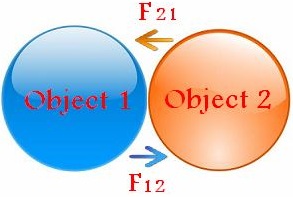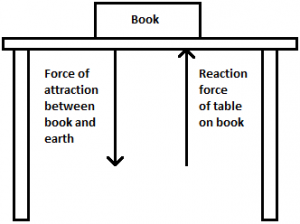Sir Isaac Newton gave his third law of motion in 17th century which came out as one of the most influential laws in this world.
In the first two laws of motion we learnt about what is force and how can we calculate its magnitude. In the third law of motion we will get to know one of the important characteristics of force. Third law of motion is based on the action and reaction force. For example, when we sit on a chair, our body feels a force in a downward direction while chair feels a force in the opposite direction which is in equal amount. This explained according to the third law of motion.
What is Newton’s Third Law of Motion?
It states that, “To every action there is an equal and opposite reaction”.

Consider that there are two objects 1 and object 2. If both the objects interact with each other, then the force exerted on the object 2 by the object 1 (F₂₁) is equal in magnitude and opposite in direction to the force exerted on the object 1 by the second object (F₂₁).
F₁₂ = – F₂₁
F₁₂ + F₂₁ = 0
According to this law, if the motion of the object gets affected due to some force, then this force which affects the motion of the object must come from the other object external to the first object. The second object also experience same magnitude force but in the opposite direction to the force applied by itself. We can derive an important theory from this concept that isolated force does not exist in the nature. The force exerted by the object A in the object B can be stated as the action force and force exerted by the second object B on the object A can be stated as reaction force.
Examples of Newton’s Third Law of Motion:
- Book kept on a table: A book lying on a table exerts a force on the table which is equal to the weight of the book. This is the force of action. The table supports the book, by exerting an equal force on the book. This is the force of reaction, as shown in the below figure. As the system is at rest, net force on it is zero. Therefore, forces of action and reaction must be equal and opposite.

- A tea cup breaks on falling on the ground: Tea cup exerts certain force (action) on ground while the ground exerts an equal and opposite reaction on the cup. Ground is able to withstand the action of cup, but the cup being relatively more delicate breaks due to reaction.
- It is difficult to walk on sand or ice: This is because on pushing, sand gets displaced and reaction from sandy ground is very little. In case of ice, force of reaction is again small because friction between feet and ice is very small.
- Walking on the ground: While walking a person passes the ground in the backward direction (action) by his feet. The ground pushes the person in forward direction with an equal force (reaction). The component of reaction in the horizontal direction makes the person move forward.
How to find the Newton’s Third Law of Motion?
Example: A person of mass 85 kg is standing in a lift which is accelerating downwards at 0.45m/sec². Draw a diagram to show the forces acting on the person and calculate the force the person exerts on the floor of the lift.
Solution: The weight of the person is 85 g, where g is the acceleration due to gravity. The resultant force is W − R and using Newton’s second law gives:
F = ma
W – R = 85 x 0.45
R = W – 85 x 0.45
= 85 x 9.81 – 85 x 0.45 = 795.6 N ≈ 796 N
Therefore, using Newton’s third law the force the person exerts on the floor of the lift is equal to the force of the floor acting on the person, i.e. R, which equals 796 N.
